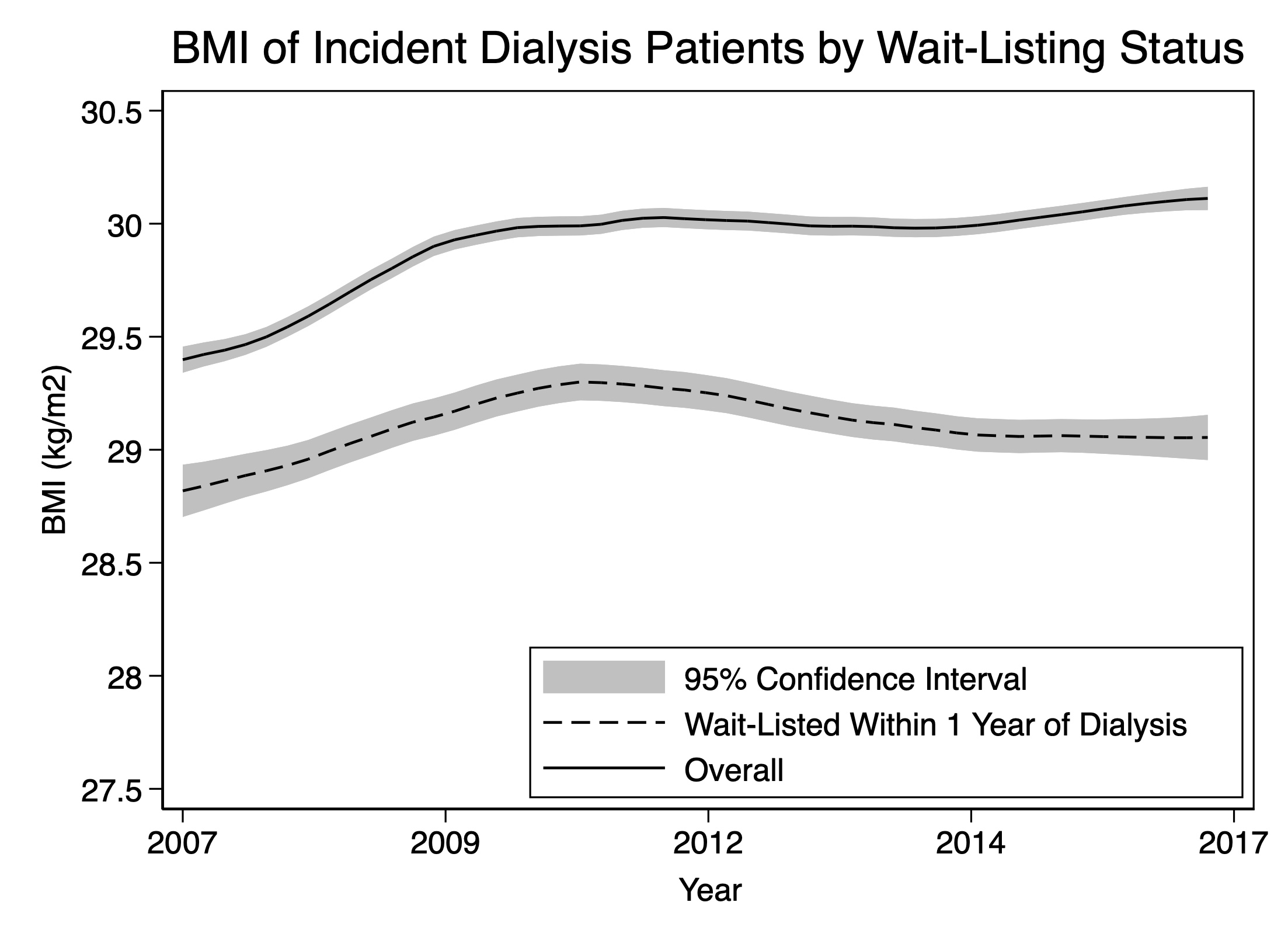Morbid Obesity: A Growing Barrier to Early Kidney Transplant Wait-Listing in the United States
1University of Pennsylvania, Philadelphia, PA, 2Fresenius Medical Care North America, Minneapolis, MN, 3Drexel University Dornsife School of Public Health, Philadelphia, PA, 4Drexel University College of Nursing and Health Professions, Philadelphia, PA, 5University of Delaware, Newark, DE, 6Drexel University College of Medicine, Philadelphia, PA
Meeting: 2020 American Transplant Congress
Abstract number: B-223
Keywords: Kidney transplantation, Obesity
Session Information
Session Name: Poster Session B: Non-Organ Specific: Disparities to Outcome and Access to Healthcare
Session Type: Poster Session
Date: Saturday, May 30, 2020
Session Time: 3:15pm-4:00pm
 Presentation Time: 3:30pm-4:00pm
Presentation Time: 3:30pm-4:00pm
Location: Virtual
*Purpose: Kidney transplant (KT) programs may be more reluctant to accept transplant candidates with morbid obesity due to concerns about higher post-operative risks. We examined trends in morbid obesity among US incident dialysis patients, and the association between morbid obesity and access to the KT waiting list.
*Methods: Using data from the US Renal Data System, we included adults age ≥ 18 years who initiated dialysis in the US between January 1, 2007 and December 31, 2016 and survived ≥ 1 year. Those with missing data on body mass index (BMI) were excluded (N=72,879). We defined morbid obesity as BMI≥40 kg/m2 at dialysis initiation. Our outcome was KT wait-listing within 1 year after dialysis initiation. We fit logistic regression models of wait-listing by morbid obesity status, adjusted for age, race/ethnicity, sex, insurance, dialysis modality, diabetes, year, and region.
*Results: There were 908,570 incident dialysis patients included in the analysis. Overall, mean BMI of incident dialysis patients that survived ≥1 year increased during the study period, whereas mean BMI in the subset who were wait-listed for KT within 1 year (N = 123,459) plateaued and then declined after 2010 (Fig). The age, race/ethnicity, and sex-adjusted prevalence of morbid obesity increased from 9.4% in 2007 (95% Confidence Interval [CI] 9.2%-9.6%) to 10.9% in 2016 (95% CI 10.7%-11.0%), with the highest adjusted prevalence of morbid obesity in ESRD Network 9 (13.2% in Kentucky, Indiana, and Ohio). Compared to those with BMI<40 kg/m2, dialysis patients with morbid obesity were more likely to be younger (mean age, 58 vs 63 years), black (34% vs 29%), female (56% vs 41%), and Medicaid-enrolled (31% vs 26%) (p<0.001 for all). In the multivariable adjusted logistic regression model, compared to incident dialysis patients with BMI<40 kg/m2, those with morbid obesity were nearly two-thirds less likely to be wait-listed for KT within 1 year of dialysis (adjusted odds ratio 0.36, 95% CI 0.35-0.37, p<0.001).
*Conclusions: Among US incident dialysis patients, morbid obesity is increasingly common. Dialysis-dependent adults with morbid obesity are substantially less likely than their counterparts with lower BMI to be wait-listed for KT within 1 year of starting dialysis.
To cite this abstract in AMA style:
Lavenburg L, Weinhandl E, Robinson L, Milliron B, Earthman C, Klassen A, Harhay M. Morbid Obesity: A Growing Barrier to Early Kidney Transplant Wait-Listing in the United States [abstract]. Am J Transplant. 2020; 20 (suppl 3). https://atcmeetingabstracts.com/abstract/morbid-obesity-a-growing-barrier-to-early-kidney-transplant-wait-listing-in-the-united-states/. Accessed December 17, 2025.« Back to 2020 American Transplant Congress

